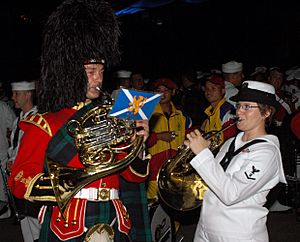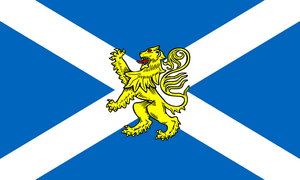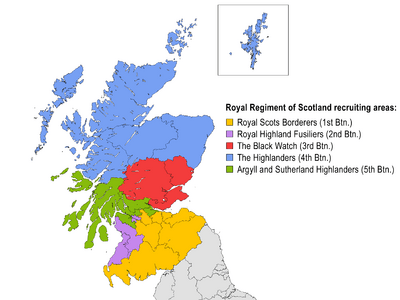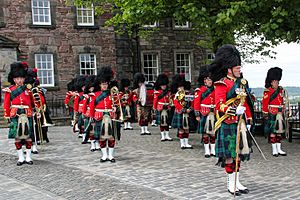Royal Regiment of Scotland facts for kids
Quick facts for kids Royal Regiment of Scotland |
|
|---|---|
| Active | 28 March 2006 – present |
| Allegiance | |
| Branch | |
| Type | Infantry |
| Role |
1st Battalion: Specialised Infantry
2nd Battalion: Light Infantry 3rd Battalion: Light Mechanised Infantry 4th Battalion: Strike Mechanised Infantry Balaklava Coy: Public duties 6th Battalion: Army Reserve 7th Battalion: Army Reserve |
| Size | Six battalions One reinforced company |
| Part of | Scottish, Welsh and Irish Division |
| Garrison/HQ |
RHQ: Edinburgh Castle
1st Battalion: Aldershot Garrison 2nd Battalion: Edinburgh 3rd Battalion: Fort George 4th Battalion Catterick Balaklava Company: Edinburgh 6th Battalion: Glasgow 7th Battalion: Perth |
| Motto(s) | "Nemo Me Impune Lacessit" (Latin) "No One Provokes Me With Impunity" |
| March | Quick: Scotland the Brave Slow: Royal Regiment of Scotland Slow March |
| Mascot(s) | Cruachan IV (Shetland pony) |
| Engagements | Operation Telic Operation Herrick |
| Commanders | |
| Colonel in Chief | The Queen |
| Colonel of the Regiment |
Lieutenant-General Nick Borton DSO MBE |
| Insignia | |
| Tactical Recognition Flash |  |
| Tartan | Government 1A |
| Hackle | Blackcock Feathers From the Royal Scots and King's Own Scottish Borderers |
| Abbreviation | SCOTS |
The Royal Regiment of Scotland is a very important Scottish infantry group in the British Army. It is the main Scottish infantry regiment. It has four regular battalions (groups of soldiers) and two reserve battalions (soldiers who train part-time). It also has a special company. Each of these groups used to be a separate regiment. Many battalions still keep their old traditions, like their pipes and drums bands.
Contents
The History of the Royal Regiment
How the Regiment Was Formed
The Royal Regiment of Scotland was created as part of a big change in the British Army. The plan was announced in 2004. Several older Scottish regiments joined together to form this new, larger regiment. The goal was to make the army more efficient and help with recruiting new soldiers.
The regiment officially started on March 28, 2006. It brought together famous regiments like the Royal Scots and the King's Own Scottish Borderers. Even though they joined, most battalions kept their old names as part of their new titles. This helps them remember their unique history.
Keeping Old Traditions Alive
The Royal Regiment of Scotland has a common cap badge, which is the symbol soldiers wear on their hats. They also share a special tartan pattern and a type of hat called a Glengarry. However, each battalion wears a different coloured feather, called a hackle, on their hat. This helps them keep their own special identity.
The pipes and drums bands of each battalion still wear the traditional uniforms and tartans of their old regiments. This way, the music and look of each historic group live on. The regiment also has its own military band, which plays music for ceremonies.
Challenges and Changes
Creating the new regiment was not easy. Some former soldiers and groups in Scotland were not happy about it. They worried that the older traditions of some regiments, especially those from the Lowlands of Scotland, might be lost. These Lowland units traditionally wore trousers called trews, while Highland units wore kilts. The new regiment mostly wears kilts.
However, the army believed that combining the regiments would make them stronger and better at their jobs. It would also help solve problems with finding and keeping enough soldiers.
One famous regiment, the Black Watch, was especially talked about during these changes. At the time, their soldiers were serving in a dangerous part of Iraq. Some people felt that the changes were unfair to them and might hurt their morale. Despite these concerns, the changes went ahead.
In 2012, more changes happened. The 5th Battalion, the Argyll and Sutherland Highlanders, became a smaller company. This company now mainly performs ceremonial duties, like guarding important places in Scotland.
How the Regiment is Organized
To keep their local connections, all battalions in the Royal Regiment of Scotland use the names of their former regiments. Here's how they are set up:
- Regular Battalions
- Royal Scots Borderers, 1st Battalion: These are specialist infantry soldiers. They are based in Aldershot.
- Royal Highland Fusiliers, 2nd Battalion: These are light infantry soldiers. They are based at Glencorse Barracks near Edinburgh.
- The Black Watch, 3rd Battalion: These are light mechanised infantry, meaning they use vehicles. They are at Fort George in Inverness.
- The Highlanders, 4th Battalion: These are becoming strike mechanised infantry, ready for quick action. They are at Catterick.
- The Argyll and Sutherland Highlanders, 5th Battalion: This is a company-sized group called Balaklava Company. They perform ceremonial duties in Edinburgh.
- Reserve Battalions (part-time soldiers)
- 52nd Lowland Volunteers, 6th Battalion: These are reserve light infantry. Their main base is in Glasgow.
- 51st Highland Volunteers, 7th Battalion: These are also reserve light infantry. Their main base is in Perth.
Regimental Bands
The Royal Regiment of Scotland has several bands:
- The Band of the Royal Regiment of Scotland: This is the main military band, based in Edinburgh.
- Lowland Band of the Royal Regiment of Scotland (Reserve): This band is part of the 6th Battalion.
- Highland Band of the Royal Regiment of Scotland (Reserve): This band is part of the 7th Battalion.
Pipe Bands
Many battalions also have their own traditional pipe bands:
- Pipes and Drums of the Royal Highland Fusiliers, 2nd Battalion
- Pipes and Drums of The Black Watch, 3rd Battalion
- Pipes and Drums of The Highlanders, 4th Battalion
- Pipes and Drums of the 51st Highland Volunteers, 7th Battalion (Reserve)
Regimental Museum
You can learn more about the regiment at The Museum of the Royal Scots (The Royal Regiment) and the Royal Regiment of Scotland. It is located inside Edinburgh Castle. The museum has many interesting things like uniforms, medals, weapons, and drums. It shows the regiment's history from when it started to what army life is like today.
Colonel-in-Chief
The regiment's special leader, called the Colonel-in-Chief, is The Queen. The Queen is a very important figure for the regiment. Other members of the Royal Family also serve as "Royal Colonels" for different battalions:
- 1st Battalion: The Princess Royal
- 2nd Battalion: The Duke of York
- 3rd Battalion: The Duke of Rothesay
- 4th Battalion: The Duke of Edinburgh
- 5th Battalion: The Queen
- 6th Battalion: The Princess Royal
- 7th Battalion: The Duke of Rothesay
Uniforms and Dress


Cap Badge and Motto
The new cap badge was shown for the first time in 2005. It combines two important Scottish symbols: the Saltire of St Andrew (the Scottish flag) and the Lion Rampant (a lion standing on its hind legs) from the Royal Standard of Scotland. A crown sits on top of the badge.
The regiment's motto is Nemo Me Impune Lacessit. This is a Latin phrase that means "No One Provokes Me With Impunity." It is also the motto of the Order of the Thistle, which is Scotland's highest award for knights.
Dress Uniforms
The regiment's uniforms combine special features from the old regiments. Here are some examples:
- All battalions wear a type of hat called a Glengarry.
- They attach blackcock tail feathers to their Glengarry hats, a tradition from older regiments.
- The regiment's tartan is called Government 1A, which is a version of the Black Watch tartan.
- The kilt is sewn in a special way, and the Sporran (a pouch worn with the kilt) has a design from the Black Watch.
- The socks (called hose) are black and red, and the shoes (called Brogues) have black buttons.
- The main band of the regiment wears a tall hat with feathers, called a Feather bonnet, and a bright red jacket for special occasions.
Hackle Colours
When soldiers wear their combat uniform, they wear a special coloured feather (a hackle) on their Tam O'Shanter hat. Each battalion has its own colour:
- 1st Battalion: Black
- 2nd Battalion: White
- 3rd Battalion: Red
- 4th Battalion: Blue
- 5th Battalion: Green
- 6th Battalion: Grey
- 7th Battalion: Purple
Regimental Mascot
The official mascot of the Royal Regiment of Scotland is a Shetland pony named Cruachan. The first pony mascot was given to one of the older regiments in 1929. The current mascot is Cruachan IV, who joined the regiment in 2012.
Alliances
The Royal Regiment of Scotland has special connections, called alliances, with other military units around the world. These connections are often with regiments that share a similar history or traditions. Here are some of them:
 Canada: The Canadian Scottish Regiment (Princess Mary's)
Canada: The Canadian Scottish Regiment (Princess Mary's) Canada: Royal Newfoundland Regiment
Canada: Royal Newfoundland Regiment Canada: 1st Battalion, The Royal New Brunswick Regiment (Carleton and York)
Canada: 1st Battalion, The Royal New Brunswick Regiment (Carleton and York) Australia: 25th/49th Battalion, The Royal Queensland Regiment
Australia: 25th/49th Battalion, The Royal Queensland Regiment Malaysia: 5th Battalion, The Royal Malay Regiment
Malaysia: 5th Battalion, The Royal Malay Regiment South Africa: Bambatha Rifles
South Africa: Bambatha Rifles Royal Navy: HMS Edinburgh
Royal Navy: HMS Edinburgh Canada: The Royal Highland Fusiliers of Canada
Canada: The Royal Highland Fusiliers of Canada New Zealand: The Royal New Zealand Infantry Regiment
New Zealand: The Royal New Zealand Infantry Regiment Pakistan: 11th Battalion, The Baloch Regiment
Pakistan: 11th Battalion, The Baloch Regiment South Africa: Chief Maqoma Regiment
South Africa: Chief Maqoma Regiment Canada: The Black Watch (Royal Highland Regiment) of Canada
Canada: The Black Watch (Royal Highland Regiment) of Canada Canada: 42nd Field Artillery Regiment (Lanark and Renfrew Scottish), RCA
Canada: 42nd Field Artillery Regiment (Lanark and Renfrew Scottish), RCA Canada: The Prince Edward Island Regiment (RCAC)
Canada: The Prince Edward Island Regiment (RCAC) Australia: The Royal Queensland Regiment
Australia: The Royal Queensland Regiment Australia: The Royal New South Wales Regiment
Australia: The Royal New South Wales Regiment South Africa: Solomon Mahlangu Regiment
South Africa: Solomon Mahlangu Regiment New Zealand: The New Zealand Scottish
New Zealand: The New Zealand Scottish Royal Navy: HMS Montrose
Royal Navy: HMS Montrose Canada: The Cameron Highlanders of Ottawa (Duke of Edinburgh's Own)
Canada: The Cameron Highlanders of Ottawa (Duke of Edinburgh's Own) Canada: The 48th Highlanders of Canada
Canada: The 48th Highlanders of Canada Canada: The Queen's Own Cameron Highlanders of Canada
Canada: The Queen's Own Cameron Highlanders of Canada Canada: The Seaforth Highlanders of Canada
Canada: The Seaforth Highlanders of Canada Canada: The Toronto Scottish Regiment (Queen Elizabeth The Queen Mother's Own)
Canada: The Toronto Scottish Regiment (Queen Elizabeth The Queen Mother's Own) Australia: 7th Battalion, The Royal Australian Regiment
Australia: 7th Battalion, The Royal Australian Regiment Australia: 5th/6th Battalion, Royal Victoria Regiment
Australia: 5th/6th Battalion, Royal Victoria Regiment Australia: The Royal South Australia Regiment
Australia: The Royal South Australia Regiment Australia: 16th Battalion, The Royal Western Australia Regiment
Australia: 16th Battalion, The Royal Western Australia Regiment New Zealand: The Otago and Southland Regiment
New Zealand: The Otago and Southland Regiment New Zealand: The Wellington (City of Wellington's Own) and Hawke's Bay Regiment
New Zealand: The Wellington (City of Wellington's Own) and Hawke's Bay Regiment South Africa: Gonnema Regiment
South Africa: Gonnema Regiment Royal Navy: HMS Sutherland
Royal Navy: HMS Sutherland Royal Navy: HMS Victorious
Royal Navy: HMS Victorious Canada: The Argyll and Sutherland Highlanders of Canada (Princess Louise's)
Canada: The Argyll and Sutherland Highlanders of Canada (Princess Louise's) Canada: The Calgary Highlanders
Canada: The Calgary Highlanders Australia: The Royal Queensland Regiment
Australia: The Royal Queensland Regiment Australia: The Royal New South Wales Regiment
Australia: The Royal New South Wales Regiment Pakistan: 1st Battalion (Scinde), The Frontier Force Regiment
Pakistan: 1st Battalion (Scinde), The Frontier Force Regiment Royal Navy: HMS Argyll
Royal Navy: HMS Argyll
Lineage: How the Regiment Came Together
This table shows how many older regiments joined to form the Royal Regiment of Scotland over time. It's like a family tree for the regiment!





